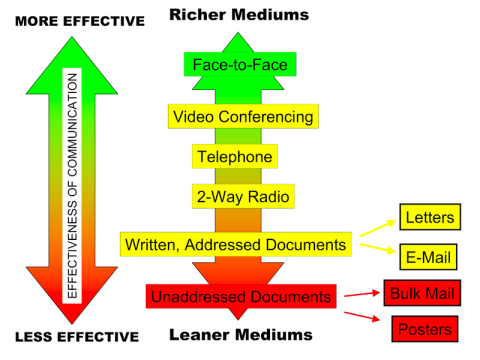Media Richness Theory
Not Rich Enough for a Complex Task?
In the working paper van Veenen limits his primary examples of Online Dispute Resolution tools to those that rely mainly on textual information (as compared to video chats, for instance). He justifies this approach by suggesting that text-based approaches have a good chance of aging well as technology advances, working as planned across many different platforms (computer, tablet, smartphone, etc.). However, he is quick to point out some of the limitations of the medium as identified by early CMC theorists like Richard L. Daft and Robert H. Lengel 1.
Daft and Lengel developed a theory about organizational communication known as Media Richness Theory. Essentially, online text-based communication is said to be less rich than other media on a number of important levels. For practitioners hoping to replace face-to-face mediation with an online tool, text-based approaches may seem to lack the immediacy and nuanced communication that face-to-face communication permits.
Media Richness Theory Explained
Media Richness Theory provides a framework for describing a communication medium's ability to reproduce the information sent over it without loss or distortion. For example, a phone call will not be able to reproduce visual social cues such as gestures. This makes it less rich (as a communication medium) than video conferencing, which is able to communicate gestures to some extent, but more rich than email. Specifically, media richness theory states that the more ambiguous and uncertain a task is, the richer format of media suits it.

The diagram above comes from the Wikipedia entry for Media Richness Theory. As summarized there,
"Information richness is defined by Daft and Lengel as 'the ability of information to change understanding within a time interval'. Communications that can overcome different frames of reference and clarify ambiguous issues to promote understanding in a timely manner are considered more rich. Communications that take a longer time to convey understanding are less rich.
According to Daft and Lengel's theory, media richness is a function of (1) the medium's capacity for immediate feedback, (2) the number of cues and channels available, (3) language variety; and (4) the degree to which intent is focused on the recipient. The greater social presence of a medium creates a greater immediacy and warmth of the communication, because of the greater number of channels."
1 Daft, R.L. & Lengel, R.H. (1986). Organizational information requirements, media richness and structural design. Management Science 32(5), 554-571.
Licensed under the Creative Commons Attribution Non-commercial No Derivatives 3.0 License
For Educational Use Only